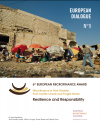- COVID-19
- News
- Blog
- Resources
- Latest publications
- Action Group publications
- European Microfinance Week
- European Microfinance Week 2019
- European Microfinance Week 2018
- European Microfinance Week 2017
- European Microfinance Week 2016
- European Microfinance Week 2015
- European Microfinance Week 2014
- European Microfinance Week 2013
- European Microfinance Week 2012
- European Microfinance Week 2011
- European Microfinance Week 2010
- European Microfinance Week 2009
- European Microfinance Week 2008
- Briefs
- Conference Reports
- European Dialogues
- European Microfinance Award
- Newsletters
- Other
- Other Action Group Publications
- Trainings & webinars
- Videos
- e-MFP Activity Reports
- Action groups
- Advancing Refugee Finance Action Group
- Better Metrics for Effective Savings Action Group
- DIGITAL INNOVATIONS FOR FINANCIAL EMPOWERMENT
- From Research to Practice
- Green Inclusive & Climate Smart Finance
- Human Resources Action Group
- Investors
- Investors in Tier 2/3 MFIs
- Making microfinance investment responsible
- Remittances
- Research in microfinance
- Rural outreach & innovation
- University meets microfinance
- Youth financial inclusion
- WASH Action Group
- Microfinance week
- European Microfinance Week 2024
- European Microfinance Week 2023
- European Microfinance Week 2022
- EUROPEAN MICROFINANCE WEEK 2021
- European Microfinance Week 2020
- European Microfinance Week 2019
- European Microfinance Week 2018
- European Microfinance Week 2017
- European Microfinance Week 2016
- European Microfinance Week 2015
- European Microfinance Week 2014
- European Microfinance Week 2013
- European Microfinance week 2012
- European Microfinance week 2011
- European Microfinance Week 2010
- European Microfinance Week 2009
- European Microfinance Week 2008
- Award
- European Microfinance Award 2024
- European Microfinance Award 2023
- European Microfinance Award 2022
- European Microfinance Award 2021
- European Microfinance Award 2020
- European Microfinance Award 2019
- European Microfinance Award 2018
- European Microfinance Award 2017
- European Microfinance Award 2016
- European Microfinance Award 2015
- European Microfinance Award 2014
- European Microfinance Award 2012
- European Microfinance Award 2010
- European Microfinance Award 2008
- FI Compass
- Other activities








2